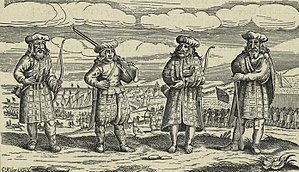
Warfare in early modern Scotland includes all forms of military activity in Scotland or by Scottish forces, between the adoption of new ideas of the Renaissance in the early sixteenth century and the military defeat of the Jacobite movement in the mid-eighteenth century.
In the late Middle Ages, Scottish armies were assembled on the basis of common service, feudal obligations and money contracts of bonds of manrent. In 1513 these systems produced a large and formidable force, but in the mid-sixteenth century there were difficulties in recruitment. Individuals were expected to provide their own equipment, including axes and pole arms. Highland troops often brought bows and two-handed swords. Heavy armour was abandoned after the Flodden campaign. Highland lords tended to continue to use lighter chainmail and ordinary highlanders dressed in the plaid. The crown took an increasing role in the supply of equipment. The pike replaced the spear and the Scots began to convert from the bow to gunpowder firearms. Feudal heavy cavalry were replaced with light horse, often drawn from the Borders. James IV established a gun foundry in 1511 and gunpowder weaponry fundamentally altered the nature of castle architecture. In the 1540s and 1550s, Scotland was given a defended border of earthwork forts and additions to existing castles.
There were attempts to create royal naval forces in the fifteenth century. James IV founded a harbour at Newhaven and a dockyard at the Pools of Airth. He acquired a total of 38 ships including the Great Michael, at that time the largest in Europe. Scottish ships had some success against privateers, accompanied the king on his expeditions to the islands, and intervened in Scandinavia and the Baltic, but were sold after the Flodden campaign. Scottish naval efforts subsequently relied on privateering captains and hired merchantmen. Despite truces with England there were periodic outbreaks of a guerre de course. James V built a new harbour at Burntisland in 1542. The chief use of naval power in his reign were a series of expeditions to the Isles and France. The Union of Crowns in 1603 ended conflict with England, but England's foreign policy opened up Scottish shipping to attack. In 1626 a squadron of three ships were bought and equipped for protection and there were marque fleets of privateers. In 1627, the Royal Scots Navy and privateers participated in the major expedition to Biscay. The Scots also returned to West Indies and in 1629 took part in the capture of Quebec.
In the early seventeenth century large numbers of Scots took service in foreign armies involved in the Thirty Years' War. As armed conflict between the Covenanter regime in Scotland and Charles I in the Bishops' Wars became likely, many mercenaries returned home, including experienced leaders like Alexander and David Leslie and these veterans played an important role in training recruits. Covenanter armies intervened in the Wars of the Three Kingdoms in England and Ireland. Scottish infantry were generally armed with a combination of pike and shot, but individuals may have had weapons including bows and polearms. Most cavalry were probably equipped with pistols and swords, but may have included lancers. Royalist armies, like those led by James Graham, Marquis of Montrose (1643–44) and in Glencairn's rising (1653–54), were mainly composed of conventionally armed infantry with pike and shot. Montrose's forces were short of heavy artillery suitable for siege warfare and had only a small force of cavalry. During the Bishops' Wars, Scottish privateers took English prizes. After the Covenanters allied with the English Parliament they established two patrol squadrons for the Atlantic and North Sea coasts, known collectively as the "Scotch Guard". The Scottish navy was unable to withstand the English fleet that accompanied the army led by Cromwell that conquered Scotland in 1649–51 and Scottish ships and crews were split up among the Commonwealth fleet. During the English occupation, more fortresses in the style of the trace italienne were built.
At the Restoration, infantry regiments and a few troops of horse were established and there were attempts to found a national militia on the English model. The standing army was mainly employed in the suppression of Covenanter rebellions and the guerrilla war undertaken by the Cameronians in the East. Pikemen became less important and after the introduction of the socket bayonet disappeared altogether, while matchlock muskets were replaced by the more reliable flintlock. On the eve of the Glorious Revolution the standing army in Scotland was about 3,250 men. The Scots were drawn into King William II's continental wars. Scottish seamen received protection against arbitrary impressment, but a fixed quota of conscripts for the Royal Navy was levied from the sea-coast burghs. There were now Royal Navy patrols in Scottish waters even in peacetime. Scottish privateers played a major part in the Second Anglo-Dutch War. In the 1690s a fleet of five ships was established for the Darien Scheme, and a professional navy of three warships to protect local shipping. After the Act of Union in 1707, these vessels were transferred to the Royal Navy. At the Union, the standing army was seven units of infantry, two of horse and one troop of Horse Guards, besides varying levels of fortress artillery. As part of the British Army, Scottish regiments took part in a series of wars on the European continent. The first official Highland regiment to be raised for the British army was the Black Watch in 1740, but the growth of Highland regiments was delayed by the 1745 Jacobite Rebellion. The bulk of Jacobite armies were made up of Highlanders, serving in clan regiments. The Jacobites often started campaigns poorly armed, but arms became more conventional as the rebellions progressed.